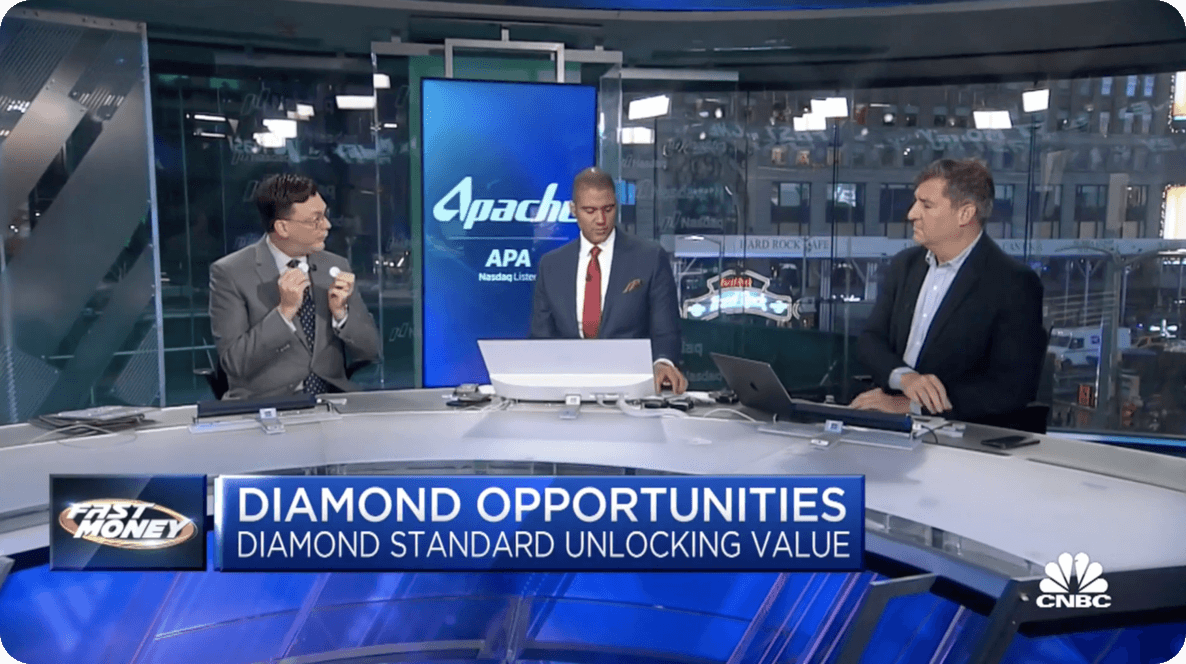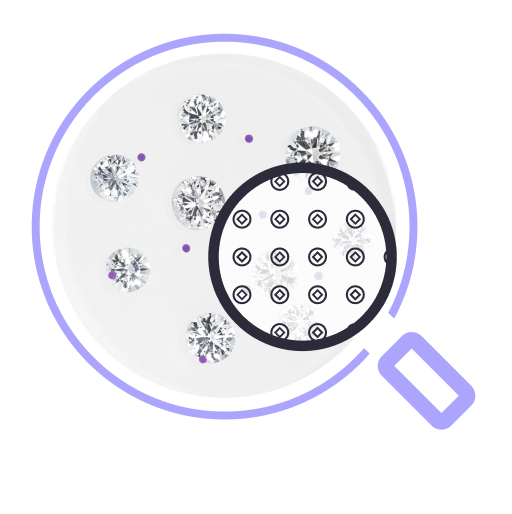Diamonds: The Underallocated Opportunity
While investors usually hold 15% to 28% of precious metals...
... with Diamonds, that share is only 1%
During past recessions, gem-quality diamonds have outperformed stocks and bonds, yet most investors—even trillion-dollar asset managers—don’t leverage this hard asset. The estimated value of the above ground diamond supply is $1.2 trillion, but 99% of that is used solely for jewelry. Just the remaining 1% is held by investors, mostly trading through art auction houses.
Compare that to investor holdings of precious metals: approximately 30% of the world’s gold, 19% of silver, 17% of platinum and 15% of both palladium and rhodium. If 15% of pent-up demand is unlocked by a market-traded diamond commodity, investor allocations could amount to $180 billion at current values.
Precious metals are proven investments in periods of recession, uncertainty and economic crisis. In 2020, gold actually outperformed the S&P 500 stock index, reaching an all-time high price of $2,067 per ounce. The ability to use diamonds as a liquid investment offers investors an opportunity to diversify portfolios and protect against inflation, and possibly generate a substantial return.
Investor Holdings of Hard Natural Resources
Gold
of
$9T
Diamonds
of
$1.2T
Underallocated Opportunity
Silver
of
$1.1T
Platinum
of
$0.03T
Palladium
of
$0.02T
Investors Holdings
Total Supply
Underallocated Opportunity
Investors Holdings
Total Supply
Diamonds are uniquely positioned to rise in value in the coming years. Prices are near an all-time low and the global supply is diminishing. DeBeers estimates a 1%–2% supply decline annually until 2030, with some analysts projecting a drop of up to 5%. Unprecedented investment demand will significantly impact diamond prices in the coming years.
Precious metals are proven investments in periods of recession, uncertainty and economic crisis. In 2020, gold actually outperformed the S&P 500 stock index, reaching an all-time high price of $2,067 per ounce. The ability to use diamonds as a liquid investment offers investors an opportunity to diversify portfolios and protect against inflation, and possibly generate a substantial return.
Unprecedented Investment Demand
Diamonds are uniquely positioned to rise in value in the coming years. Prices are
near an all- time low and the global supply is diminishing. Unprecedented investment demand willsignificantly
impact diamond prices in the coming years.
Fungibility
Investors have been unable to leverage diamonds as an asset because the variations in diamond weight, color and clarity grades result in vast disparities in private valuations, which are highly subjective and secretive. Diamonds could not be “marked to market” reliably or traded efficiently.
To establish diamonds as a regulator approved asset, key concerns around consistency, valuation and transparency had to be resolved. The blueprint to establishing the Diamond Standard: fungibility.
Transparent & Regulated
The Diamond Standard Coin—containing diamonds from around the world sourced via an
electronic exchange with a market maker to force price discovery—finally makes diamonds
fungible because every coin has the same value. The diamonds are not valued by price
estimates but by bids and transactions. Like gold, the standardized coins are priced by the
market every day.
As a market maker, Diamond Standard bids on millions of diamonds to buy statistically identical samples, that achieve the "Diamond Standard." It's like the .999 for gold.Every coin contains an optimized set of natural diamonds that add up to an equivalent geological scarcity of carat weight, color, and clarity.Every sample and every coin are public and are designed to have the same market value.Every sample and every coin are public and are designed to have the same market value.Learn more
All Coins are Equivalent
Each Diamond Standard Coin contains 8–9 diamonds selected by an optimization system from
a public, statistically valid sample of all diamonds. Each coin has equal value by containing the
same aggregate geological content. The contents of every market maker sample and every
coin are always public for anyone to verify.
The Diamond Standard
Every Diamond Standard Coin has the same value and can be traded on an exchange like other
commodities, with low transaction friction. Investor holdings can be priced to market daily and
the commodity enables securities like futures, options and ETFs to be developed.
The Coin
The Diamond Standard process revolutionizes the diamond supply chain by consolidating
liquidity, enforcing price discovery, establishing transparency and
fairness standards and reducing friction.
Each coin contains a military-grade wireless computer chip that enables instant authentication, audit and trading. The chip stores a regulator licensed blockchain token. Ownership, transactions and liens are all recorded on a public blockchain.
Investors can take delivery of the physical coin or choose to store it with a custodian in a smart cabinet that enables remote auditing. The owner controls the key to the coin’s token.
In hand, the coin can be transacted and authenticated seamlessly using a smartphone.
Diamond Price History
By solving the fungibility challenge, Diamond Standard brings to diamonds the same securities
as are available for precious metals. A regulator approved diamond commodity will inspire a
period of position-building by investors, which we estimate will reach 15% of the diamond
supply, totaling $180 billion and raising prices three to eight times.
An Investor’s Best Friend
With $1.2 trillion in above-ground value—more than all the world’s silver and platinum combined—in the eyes of investors, diamonds are beautiful for a different reason. They are a dense, easy to store, portable hard asset. And diamonds are a highly constrained natural resource—no substantial new mine has been discovered in 20 years.
Historically, diamond prices have been uncorrelated to stocks, bonds and other commodities, and have outperformed these assets in times of uncertainty.
Diamonds are an incredible asset, being made accessible to investors for the first time. As the Diamond Standard commodity becomes available through new vehicles, a secular phase of position-building may generate substantial returns for early buyers.
The timing is perfect. Gold (and equities) are at an all-time high, while diamonds are near an all-time low. Diamonds are finally an attractive asset.
Hear From Our
Founder & CEO
Software Pioneer and Founder & CEO of Diamond Standad

Invest in DIAMOND STANDARD CO. Offerings
Smart commodity you can hold in your hand

CARATS
Commodity Token / $100 minimum
$ 1.082
- A commodity token issued from Diamond Standard Commodities
- Instantly redeemable for physical diamond commodities
- Zero conversion costs between Carats and commodities

Diamond Standard Coins
Fungible Commodity
$ 2,810
- Contains 0.18 to 0.75 carat stones in a 35mm diameter transparent Coin
- Buy and sell on the Spot Market
- All diamonds independently graded by GIA or IGI

Diamond Standard Bars
Fungible Commodity
$ 28,100
- Contains 0.76 to 2.05 carats stones in a 70mm by 35mm transparent Bar
- Valued at 10 times the market price of a Coin
- Lowest commodity custody fees

Diamond Standard Fund
For Accredited Investors
- Shares offered in a private placement pursuant to Rule 506(c) under Regulation D
- Co-sponsored by Diamond Standard and Horizon Kinetics
- Third party administration by NAV
